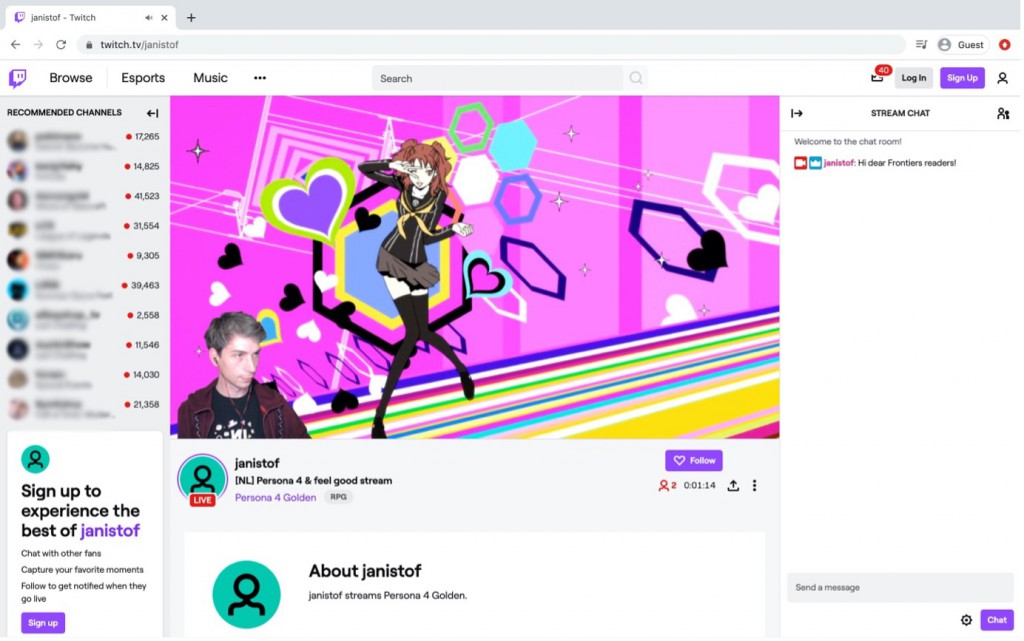In this blog post, Jan de Wit writes about an article he recently published together with NMD graduates Alicia van der Kraan and Joep Theeuwes. In this article, they present the findings of the research that Alicia and Joep conducted for their master’s theses. It was published in a special issue on digital games and mental health, as part of the journal Frontiers in Psychology. You can find the full article here.
There is a rise in the popularity of live streaming platforms, on which streamers broadcast content, mostly related to videogames, to an audience of viewers that tune in from all over the world. While watching the streamer play games, the viewers are able to interact with each other, and sometimes also with the streamer, by using the chat function that is part of the platform. These interactive features enable the streamers to build a tight-knit community around them.
Twitch from the viewer’s perspective. On the left is a list of popular channel suggestions (blurred for privacy), in the middle the broadcasted game and streamer, on the right the chat.
The majority of people active on Twitch, currently the most popular live streaming platform, are male (81.5%), and 55% of users are between 18 and 34 years old. This can be a difficult time in a person’s life, where the transition from adolescence into adulthood takes place. Not being able to successfully complete these transitional steps, including figuring out your identity, career, and relationships with others, could lead to experiencing various mental health issues such as anxiety or depression. There are several invasive life events that could happen at any age, such as break-ups, financial stress, or death of a loved one, that can lead to mental health issues as well. This particular demographic to which the majority of Twitch users belong is however relatively unlikely to seek out professional help when needed.
We therefore wondered if platforms such as Twitch could provide comfort for people going through these difficult and stressful times. We were also curious to learn whether people’s viewing behaviour changed during these difficult times, for example by actively seeking out smaller communities to have more meaningful interaction. To investigate whether this is indeed the case, we conducted a survey with 84 participants, all current Twitch viewers that were going through a difficult period in life when filling in the survey, or had experienced such a difficult period in the past.
The majority of participants indicated that Twitch helped them cope, and that it became a larger part of their lives during the difficult period compared to regular viewing. Recurring themes were the entertainment, distraction, and sense of community Twitch offers. Viewing behaviour during difficult periods appears to remain largely the same in terms of the streamers that are watched, although time spent viewing increases, and there is a change toward more time spent actively watching rather than having the stream on in the background. Several participants shared anecdotes of times when they benefitted from participating in a streamer’s community, and were sometimes even helped by the streamer directly (e.g., through self-disclosure from the streamer discussing their problems).
In summary, our research shows that streamers, supported by platforms such as Twitch, serve an important purpose for people that are active on the platform and are going through a difficult time, even without consciously attempting to do so. It is important to note, however, that the interactions that happen on Twitch are not a replacement for any kind of professional support. At the same time, we do believe that the streamers and viewers active on Twitch are able to contribute to mental health awareness and literacy, and hope that they are able to remove some of the obstacles that prevent people from seeking out additional help when needed.
